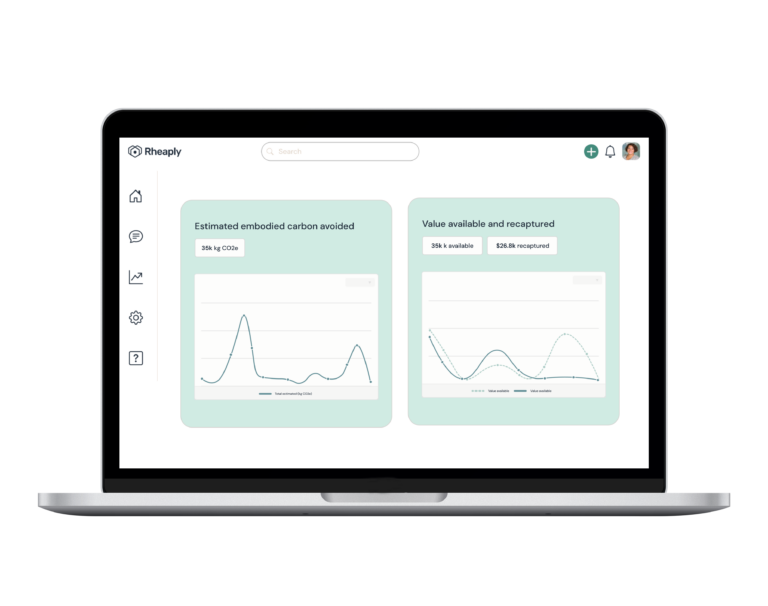ESG Reporting
Rheaply puts reuse on the table for every organization.
ESG Reporting
Environmental, social, and governance (ESG) reporting acts as a crucial tool for disclosure and transparency in the business world. Not simply a philanthropic afterthought, ESG reporting forms an essential component of an organization’s strategic operations. By putting forth the company’s wider impact, performance, and sustainability actions, ESG reporting promotes transparency that speaks directly to key stakeholders.
The primary purpose of this reporting is to improve investor transparency and inspire other organizations to do the same. Investors, growing increasingly alert to ESG risks, are demanding robust and authentic data to better understand a company’s ESG performance, which is vital to their decision-making processes. Companies are therefore required to provide specific information regarding their sustainability practices.
Transparency for investors is a fundamental aspect of ESG reporting standards. Using a recognized ESG reporting framework and adhering to ESG reporting standards, such as those set by the Global Reporting Initiative (GRI) or the Sustainability Accounting Standards Board (SASB), ensures that companies are providing consistent and material information. This clarity enables investors to have a comprehensive understanding of a company’s ESG-related risks and opportunities, which in turn supports informed investment decisions.
The benefits of ESG reporting for investors are truly extensive. First and foremost, it empowers them to effectively screen potential investments. By reviewing ESG reports, investors can sift out companies with poor performance and focus on those demonstrating solid sustainability practices. This strategy, referred to as ESG screening, has become integral in the investment decision-making process.
Second, ESG reporting allows investors to align their investment strategies with their personal values and social responsibility commitments. Through comprehensive ESG reports, investors can support companies that actively contribute towards specific social or environmental goals. In doing so, they marry financial returns with sustainable development.
More broadly speaking, ESG reporting enables investors to evaluate the long-term resilience and sustainability of potential investments. They can ascertain how well companies are prepared to handle ESG risks that can significantly impact their future profitability and survival. Additionally, companies with a strong ESG performance often attract a wider investor base. This reflects their potential for sustainable growth and value creation.
Besides serving the needs of investors, ESG reporting also acts as a blueprint for other organizations. It demonstrates how businesses can and should commit to sustainability. The practices outlined in a company’s ESG report can thus prompt other organizations to adopt similar actions, contributing to overall social and environmental sustainability on a larger scale.
Amidst these positive initiatives, however, it’s important to distinguish between authentic ESG commitments and greenwashing—companies making misleading or unsupported claims about their impact. The concern is that some businesses may leverage ESG reporting as a PR exercise, improving their public image without putting in the work. For stakeholders to differentiate genuine ESG initiatives from greenwashing, they must scrutinize the depth of ESG reporting and analyze the impact metrics provided.
Implementing a reuse platform like Rheaply is a great way for organizations to stay on top of their ESG reporting initiatives. With Rheaply, businesses can enjoy benefits like cost savings and increased employee engagement while making sure everyone is in alignment with their most critical sustainability goals.

ESG Sustainability Reporting
ESG stands for environmental, social, and governance. ESG reporting is used by investors and other stakeholders to evaluate the impact of a company’s operations in these three critical areas:
- Environmental: This pertains to a company’s interaction with the natural world and its efforts to minimize environmental damage. It includes carbon footprint and greenhouse gas emissions, energy efficiency and renewable energy use, waste management and recycling, and more.
- Social: The social component of ESG assesses how a company manages relationships with its employees, suppliers, customers, and the communities in which it operates. Some of the most pressing social factors today are employee health and safety; diversity, equity, and inclusion; human rights and labor standards; and community engagement and development.
- Governance: This evaluates a company’s leadership, executive pay, audits, internal controls, and shareholder rights. Key areas of consideration include board diversity and structure and business ethics and transparency.
While ESG and sustainability are often used interchangeably, there are some distinct nuances between the two to be aware of. ESG is an external investment framework utilized by investors to assess a company’s sustainability and societal impact. It focuses on the measurable and material aspects of the business’s operations that have a direct financial impact.
Sustainability, by contrast, is a broader concept that is often used internally by companies. It looks at their long-term ability to operate in an economically, socially, and environmentally responsible manner. Sustainability practices align business operations with the goal of long-term preservation and the growth of environmental, social, and financial capital.
ESG serves as an external investment framework, helping investors evaluate the ESG risks and opportunities associated with a certain business. Investors use ESG reporting to screen investments and ensure portfolios align with their risk tolerance and values. Essentially, it tells them whether or not partnering with an organization would be beneficial to their overall mission.
On the other hand, sustainability acts as an internal framework that guides companies in making decisions that balance profitability with long-term viability and societal impact. It allows them to identify and mitigate risks, capitalize on opportunities, and build resilience.
ESG reporting plays a critical role in attracting investors and securing financing. Investors are now realizing that companies that prioritize ESG are more likely to be successful in the long run. ESG sustainability reporting, which is driven by ESG reporting requirements, provides investors with a comprehensive understanding of a company’s ESG performance. It equips them with the data they need to make informed decisions and manage ESG risks.
Transparency in ESG reporting is crucial, and companies must adhere to various ESG reporting requirements to provide an accurate and comparable picture of their ESG performance. Many organizations follow guidance from the Task Force on Climate-Related Financial Disclosures (TCFD) to boost their performance. TCFD recommendations provide a robust framework for climate-related financial risk disclosures and can be extremely helpful to businesses as they get started with this type of reporting.
ESG Reporting Examples
The announcement from G7 finance ministers regarding their commitment to climate reporting is a substantial move in emphasizing the role of sustainability in today’s global economic landscape. By acknowledging the importance of transparent disclosure of climate-related financial risks and opportunities, the G7 nations are steering the world towards a more accountable and sustainable future.
Still, a key challenge that remains is the absence of a universal reporting standard, which has hindered successful ESG reporting in many ways. Various regional reporting frameworks, voluntary standards, and national legislations exist across the globe, but these can result in misalignment between goals and objectives. These frameworks include:
- Regional Frameworks: One of the most well-known regional frameworks is the European Union’s Non-Financial Reporting Directive (NFRD). This framework was adopted by companies in the EU.
- Voluntary Standards: Organizations may also choose to follow guidelines established by bodies like the Sustainability Accounting Standards Board (SASB) or the Global Reporting Initiative (GRI).
- National Regulation: A good example of national legislation around ESG reporting is Section 135 of India’s Companies Act, which mandates corporate social responsibility reporting.
These ESG reporting examples underline the urgent need for a universal standard to streamline and unify reporting across the board. One of the ways governing bodies are helping to standardize procedures is by adopting a common language. They promote the use of standard terms and definitions to help keep everyone on the same page when it comes to ESG-related processes.
For instance, a term that’s become pivotal in the climate reporting discourse is ESG net zero. This phrase signifies a company’s commitment to balancing the greenhouse gases it emits and the amount it removes or offsets. Essentially, the ESG net zero meaning refers to a company’s efforts to avoiding adding greenhouse gas to the atmosphere.
A notable ESG annual report is the Microsoft Corporate Social Responsibility (CSR) report, which showcases the company’s commitment to addressing a wide range of ESG issues, such as carbon neutrality, digital inclusion, and responsible AI. The report stands out for its data-driven approach, utilizing quantitative metrics and performance indicators to track progress toward sustainability goals.
Climate Reporting
Corporate social responsibility (CSR) refers to business efforts to manage and report on their environmental and social impact. It’s a relatively broad concept that varies considerably from one company to another, but generally includes:
- Economic responsibilities
- Legal responsibilities
- Ethical responsibilities
- Philanthropic responsibilities
While ESG reporting and CSR both aim to demonstrate an organization’s commitment to societal and environmental issues, they serve different purposes. Here’s a quick breakdown of the differences between the two:
- ESG Reporting: A disclosure standard used by companies to provide transparency to investors and other stakeholders about their ESG performance. It relies on specific, quantifiable measures that are typically tied to financial performance.
- CSR: This business model is typically more qualitative in nature. It focuses broadly on the company’s overall impact on society and the environment.
As emphasized previously, ESG reporting, including climate reporting, has become paramount in the modern business world. According to the TCFD, companies should integrate risks and opportunities into their financial planning and improve the way they disclose climate-related data. This commitment to TCFD reporting allows investors to make informed decisions and manage their climate-related financial risks.
The benefits of aligning with a climate reporting framework such as the TCFD include:
- Risk Management: By identifying and disclosing climate-related risks, companies can better manage these risks and build resilience.
- Investor Confidence: TCFD-aligned reporting provides investors with the data they need to assess a company’s climate-related financial risks. This has the potential to both improve investor confidence and boost capital.
- Regulatory Compliance: As climate reporting standards evolve, aligning with the TCFD recommendations can help companies stay ahead of regulatory changes.
With all the new reporting guidelines that are coming out, remaining compliant with relevant standards can be tricky. Rheaply’s sustainability services empower companies to take control of their ESG reporting by gaining greater visibility into their resource management processes. This can lead to better outcomes for stakeholders and get businesses one step closer to achieving their ultimate ESG goals.


